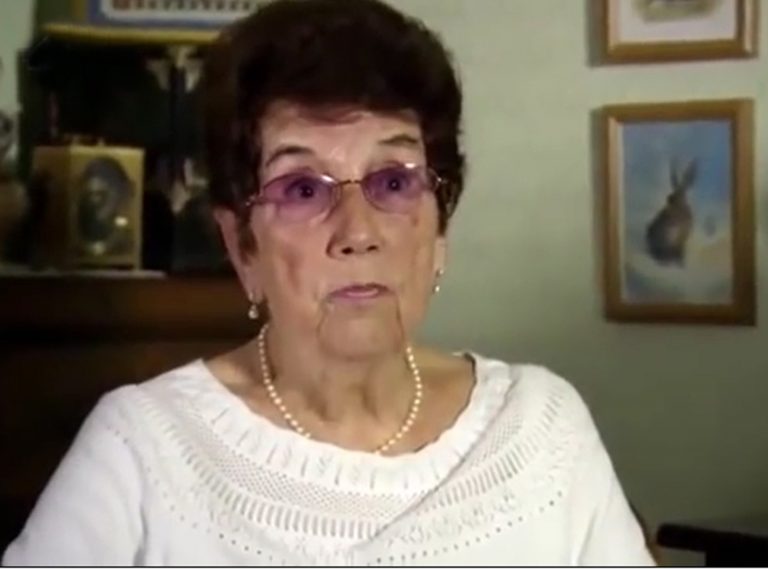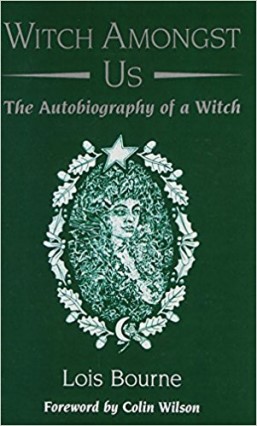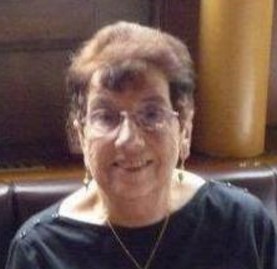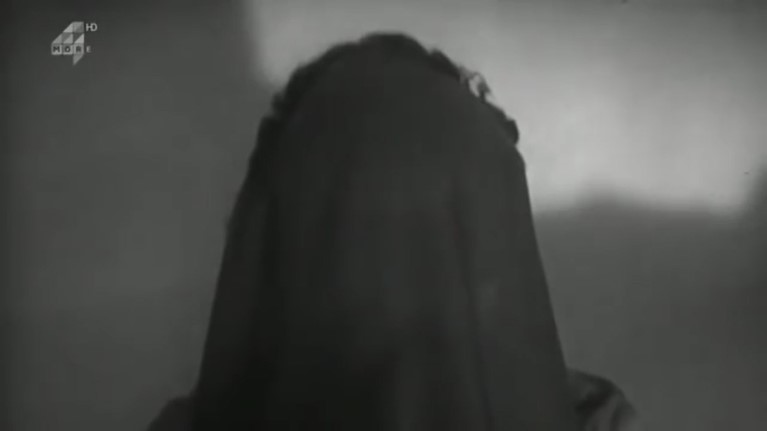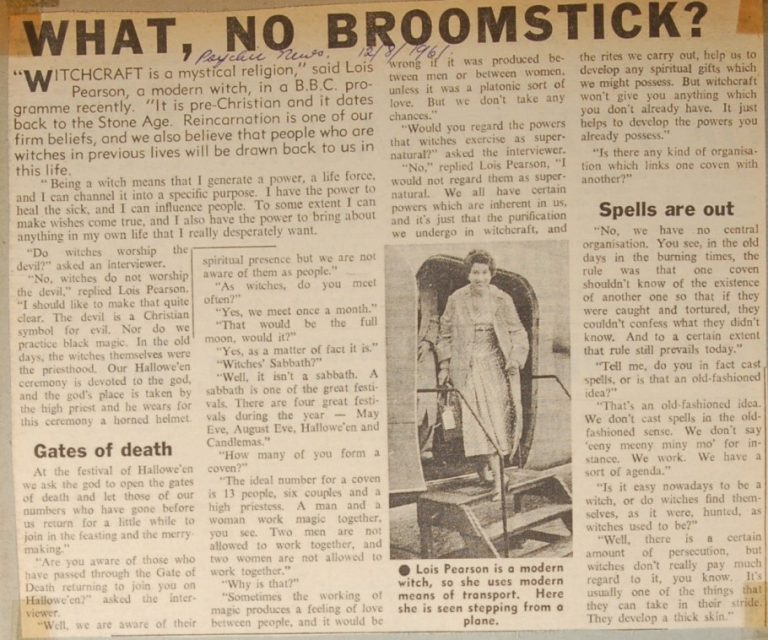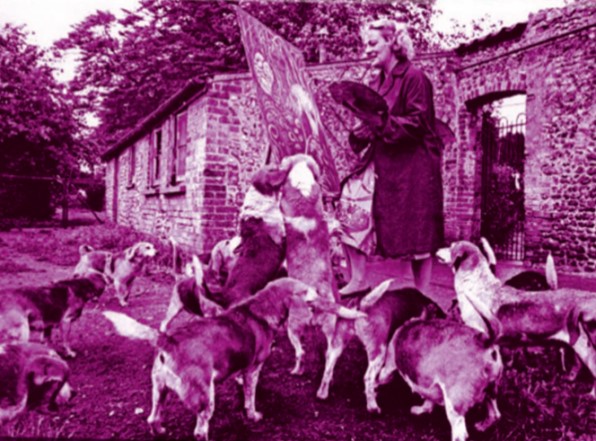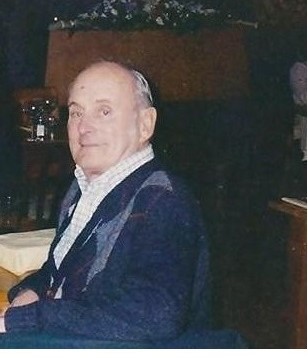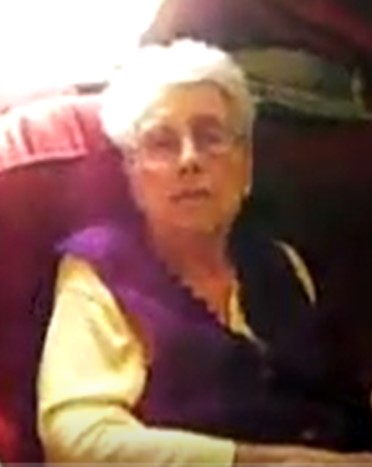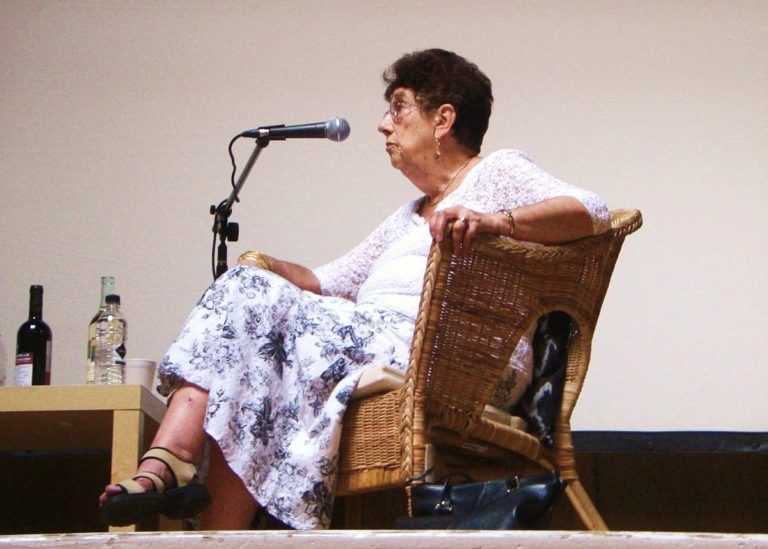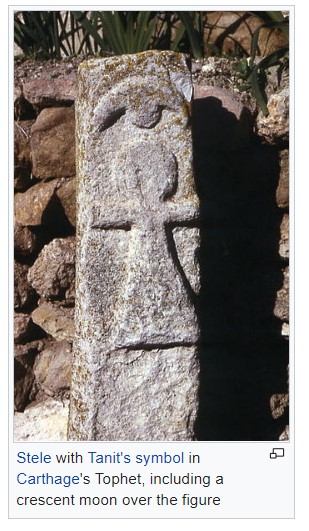There is something very special about the Gardnerian Tradition. One of those things, to me, is that we still have people within our community who lived, and worked with, and knew Gerald Gardner. It makes it all more real to me somehow.
In December of 2017, Lois Bourne passed on from this life. The title of this Wiccan Rede Online tribute to Lois is a play on words, citing the title of her autobiography A Witch Amongst Us. But it is more than that. In remembering Lois, we celebrate her life and her memory. We connect to the ways she may have shaped our practice and touched our lives, even if we are not aware of what those ways might be, and if we never met her. And in this way, she is still amongst us all.
Lois might be best remembered for being one of the early members and High Priestesses of Gerald Gardner’s Bricket Wood Coven in England. But she was more than that. There are some among us whose thirst for spirituality transcends the Gardnerian Craft and ventures into other practices. Lois was surely one of those souls, as over the course of her life she learned about many things including Ceremonial Magick, Santeria, Voodoo, Obeah, Eastern Mysticism, and other paths. She was particularly interested in Djinns, commonly known as genies. Lois studied them and noted that according to the Koran, Djinns were created from scorching heat or a smokeless flame, and they are supposed to have lived on earth long before humans. She learned that they fear iron, and people would carry daggers and wear steel rings as protection from Djinns. (In her discussions of this with Gerald, he explained that Djinns can be vengeful, especially the Djinniyats, the females.)
The very first words in Colin Wilson’s forward within her autobiography state that “Witches are born, not made…” (A phrase we will see again later in this tribute…) Lois was born on what she described as a bright Spring day, 10 April 1928. She was “the seventh child of a seventh child.”
“My mother told me years later that she was alone in the final stages of labour due to the failure of a summoning bell, and she informed the hastening midwife with typical candour, ‘If this baby is born dead, I will never forgive you.’ I was eager for life then as now, and I did not die.”
She was 17 years younger than her nearest siblings, what Lois described as being an afterthought. As the youngest, she was greatly pampered and loved. Children who are fortunate enough to have this in their youth often grow into kind, loving adults. Her brothers gave her the nickname Bunty.
As a child, Lois was introduced to an old gypsy woman who was her mother’s acquaintance. The woman looked into the little girl’s palm and said, “She will have the sight and the power.” (Lois obviously learned many things from Gerald Gardner, including his knack for story-telling.)
Lois’s had fond memories of her parents.
“My father was a gentle, quiet man who taught me about birds and plants and trees, and hardly ever scolded me for childish misdemeanours. My mother was a tempestuous volatile woman with the warm blood of the south in her veins, and less patient than my father, but warm and enveloping.”
Lois felt her mother had psychic sight as well, and that she had predicted an imminent disaster the night before Lois’s brother’s death. When Lois told her mother about visions she had, her mother listened patiently and never accused her of making them up, in spite of being part of an Anglican household.
“I know now that I was very fortunate in my choice of mother since her understanding did nothing to discourage my gradually unfolding psychic vision.”
Later in life, Lois described herself as an ordinary average-looking woman. If you sat next to her on a bus, she explained, you’d never know she was any different – unless you could sense it somehow.
While she swam upstream into many of the world’s religious paths, her main focus was witchcraft. Lois held a firm unfaded no-nonsense approach to the Craft, a trait which seems rare today.
The Craft is not for the weak, nor is it for the vain. The successful practice of witchcraft and the working of magic require that one should be psychologically healthy, mentally and physically strong, in control of one’s emotions and not subject to wild variations between high and low spirits. The inner circle of witchcraft is virtually closed, but the outside perimeter attracts its share of the psychologically disturbed, the lunatic fringe who see in the practice of witchcraft a short-cut to their heart’s desire and the possible attainment of power; there are in existence other occult groups which make useful receptacles for such would-be witches.”
She described her gifts as a latent power within herself, stirring and restless like a coiled slumbering snake flexing its muscles and longing to express itself. And then, one fateful day, a librarian gave Lois a book entitled Witchcraft Today, which Lois stated, “enthralled me, and I read it literally in hours.” This book changed her life, and perhaps our lives too. Lois wrote to the author and was invited to meet him at his home. (So, the next time you meet a Librarian, thank them for opening the pathways the way that they do.)
Over a pot of tea, Lois and Gerald spent some time discussing her experiences and listening to her questions trying to understand more about the odd things that had happened in her life, voices she heard, and things she had seen.
“He listened to me gravely and then to my surprise said, ‘It is very clear to me that you are a witch.’ I laughed and replied, ‘You are surely joking, witches don’t exist outside myths and fairy tales.’ He smiled at my naivety and explained that witches have always existed, and that the powers inherent in me were needed by our ancient ancestors in order to survive since they showed where enemies lay in wait and the direction of good hunting grounds…”
Gerald explained to Lois that as civilization evolved, this “sixth sense” atrophied as it was no longer used. While its last vestiges are ignored by most, witches are the remnants of those in which the power was still strong. Seeing promise in Lois, Gerald introduced her to the other coven members. It was there that Lois could nurture her gifts in a supportive environment, surrounded by kindred spirits. If you were fortunate enough to have experienced that type of environment in your own Craft journey, you can understand how Lois may have felt.
“I am now glad to have developed at an early age a measure of psychic perception and for its increase throughout the years of my life. I consider myself to have been exceptionally favoured to have been led to a group of people and a learned teacher, all of whom gave me the opportunity to unfold my magical powers and learn of their proper direction.”
Before the visit was over, Gerald gave Lois a copy of his novel, High Magic’s Aid, as he often did as a barometer with people. “The purpose of giving me this book was obviously to test my resolve.” What barometers or similar devices do you use today when assessing a newcomer and testing their resolve?
| Patricia Crowther |
Patricia Crowther fondly remembers Lois, although she had not worked extensively with her. Patricia explains:
I met Lois only once when Gerald invited Arnold and myself to the Halloween coven rituals at the Five Acres Sun Club, St. Albans in 1960. Gerald’s coven held their meetings in the “Cottage” which he had bought and transported to the wooded grounds of the Sun Club. Lois was the High Priestess of that coven and that night was the only time I worked with her in the Circle. When Gerald introduced us to Lois, I thought she was a very nice-looking person, and sensed she had considerable magical powers, but she said very little to us on that occasion. Over the years we exchanged letters on certain Craft matters which had to be discussed…”
Lois came to the coven after the schism between Gerald and Doreen had already taken place, so she missed those group tensions. Dayonis was HPS with Jack Bracelin as HP, and Lois became Maiden, a role which Lois described as a “deputy” to the HPS. This term (deputy) is still used today in many covens downline from Olwen, who perhaps learned the term from Lois, or vice versa.
Lois described her initiation, done at midnight on Candlemas of 1958 at the Bricket Wood cottage, as “profoundly moving” and called it one of the most important ceremonies of her life. Recuperating from surgery, Gerald was recently out of the hospital and well-enough to attend.
In her 1998 book Dancing with Witches, Lois explained that it was the coven’s custom and “their law that a woman should be initiated by a man, and a man by a woman.” To me, this is quite telling as it shows that there were key aspects to the Craft that were indeed considered “law” — and cross-gender initiation was one of them. While some portray the Craft today in a softer “anything goes” vein – it is important to remember that this more fluid mode of practice is a rather modern-day innovation and was not always considered part of the Craft.
In describing Gerald’s own firm well-defined approach to the Craft, Lois remembers that Gerald was insistent on what she called “correct procedure” – a trait which Lois appears to have absorbed through her roots and passed on to bear fruit in others she taught.
“In magical work he was meticulous and pedantic in his insistence on correct procedure, and he had a quiet persistence and watchful awareness of any slight deviation. Sometimes when working a ritual with him I would make a slight error in word or action and hoped Gerald overlooked it, but he never did, so I learned to be careful and exact in all my movements and words within the magic circle. This precision bore fruit, because my endeavours were successful, and I was encouraged to pass on this meticulousness to my students in future years.”
It seems that while our early elders did demonstrate a tremendous amount of creativity, they also believed in a structure, a discipline. What Lois called “correct procedure” echoed what she was taught by Gerald, and what Gerald was likely taught by others, to which he encouraged her to pass on to others. Sound familiar? While the vocabulary has evolved over the years and across the oceans, but what Lois describes is maintaining “Tradition.”
Is there someone in your own life who comes to mind when you read Lois’s remembrances of Gerald? If so, journal those thoughts. Save the stories and anecdotes while they are fresh in your mind, so that you can refer to them in future years as cue cards to tell your own downlines someday about their roots, and yours.
How Lois described her rituals may be somewhat different (or perhaps somewhat similar) to what people do today.
“Well, we work within a nine-foot circle, and witches work within a circle to conserve the power, unlike cabalistic magicians who work inside a circle to protect themselves from the things which materialize outside. As high priestess, I start in the east and with a sword I draw a circle. In the centre of the circle there’s an altar, and on the altar there’s usually water and salt and several tools, and at each quarter of the circle there will be a candle. When we work indoors, the candles at the quarters of the circle are to represent the fires which we would normally have if we were working outside. After I’ve drawn the circle I consecrate and bless the salt and water, and I go round the circle sprinkling water. This is to purify it, and then I purify myself. At this stage I take a sword or a witch’s knife – a black-handled knife – and I draw down the power, after having drawn a pentacle at each corner – I call them corners, but they’re points of the circle. And then I bring the other witches into the circle, and the business of the evening begins. Each one of them is purified in turn, and then we start whatever we have to do.”
“We enter into a trancelike state, and we have the power to leave our bodies and to overlook people. Now if you read books about the old witch trials, you hear about cat familiars – animal familiars. In the old days of witches, this is where the significance of the animal familiars comes in. The animals were trained; they weren’t just household pets, they were specially trained to watch over the witch’s body while she was out of it.”
“But in this day and age, you see, we have our friends around us. If we work in a circle, we have friends, and they watch over us so we don’t need the animals to see that we’re all right.”
| One gift that Lois leaves behind for all of us (including many future generations of the Craft) are her many detailed descriptions of Gerald, enabling us all to see him through her eyes. |
Lois was more than just a coven member to Gerald. She truly loved him and her grandfatherly descriptions of him show the utmost respect and compassion. She took her young sons to visit Gerald at the club, with Gerald making paper ships and airplanes with them, spinning yarns that surely bedazzled a young child’s heart. “They adored him” and later they pestered “When can we see Dr. Gardner again?”
In her books, we find more than mere mundane ink on paper. One gift that Lois leaves behind for all of us (including many future generations of the Craft) is her many detailed descriptions of Gerald, enabling us all to see him through her eyes.
“Gerald was a very gentle person, and very generous in his estimate of other people. In all the years I knew him, I never heard him utter an unkind word or criticism of anyone; he gave everyone the benefit of the doubt and always hesitated to draw conclusions without proof.”
“He was an elderly gentleman on the outside, but inside there was still Gerald the innocent little boy. This is why he got on so well with my sons; he became one with them and he did not talk down to them, as adults often do with young children.”
“I’ve visited Gerald at his home on the island on many occasions, and I loved his quaint cottage. The inside was itself almost like a miniature museum, for the walls of the lower rooms, the narrow staircase and the study upstairs were hung with swords, spears, daggers, pikes, medieval blades, Toledo rapiers, curved Saracen scimitars and the Malayan kris. Hundreds of books lay in untidy groups: books on magic, witchcraft, psychical research, secret societies, folklore, archaeology, weapons – a lifetime’s collection.”
Lois noted Gerald Gardner’s passion for the Craft and how it shaped his life. She was not just witnessing Gerald’s vision being manifested, she was an important part of that vision’s manifestation. In describing Gerald’s feeling of having true purpose and insatiable will towards the Craft, Lois conjured a very fitting (and quite Thelemic) image, quoting Jalau’ddin Rumi, founder of the Mevlevi Dervishes:
“It is as if the king had sent you to a country to carry out one special, specific task. If you go to the country and you perform a hundred other tasks, but if you have not performed the task you were sent for, it is as if you have performed nothing at all. So man has come into the world for particular task and that is his purpose. If he does not perform it, he will have done nothing.”
“For most people, the task for which they have come into the world remains obscure, but for Gerald Gardner, it was crystal clear, it was to revive and promote the acknowledgment and worship of the action gods and goddesses of our ancestors.”
She exchanged frequent letters with Gerald and described his handwriting as “very difficult to decipher, often resembling a drunken spider crawling across the page, and I asked him to type his letters.”
She told affectionate stories about Gerald, for example about him being hard of hearing, which Lois thought was a timely device so that Gerald could ask the person to repeat something, thus giving himself a bit more time to form his reply. She also noted that Gerald’s asthma attacks seemed to be timed during debates with Jack Bracelin about the club, or when Gerald could not get his way.
However, Lois staunchly defended Gerald of criticism and false accusations of sexual deviations, based solely on books written by an under-informed author in California who clearly had a biased axe to grind.
“These inventions people closely associated with him knew to be a travesty of the truth, but such rumours, so I have heard, persist even today. If he knew of the lies – and I am not at all sure that he did, because I often thought that much of the time he lived in a little world of his own – he bore it all stoically.”
“It is true that Gerald was less than completely honest on occasions, but the ancient wisdom which is the basis of witchcraft is changeless and constant, and the nature of the gods remains the same. Whether his portrayal of the craft is an accurately ancient one or modern invention is only important to pendants and historians. In the final analysis, the magic works.”
Lois became High Priestess of the coven at Bricket Wood when Dayonis left the group and moved to Canada. According to Lois, “It was a great shock to everyone…”
“As maiden of the coven, I now gravitated to being leader. I was very diffident and did not feel that my experience was sufficient for the position, but everyone was very patient with me, and over time I gained confidence and ability.”
I’m sure many of us have all felt the same way at times when fate thrusts a challenging situation upon us. Lois points out a vital lesson that is just as important today as it was decades ago: Through the supportive unity that coven members share with one another, people can gain confidence and grow, and over time they in turn can instil this very same confidence in others. As members of a coven, or the larger Gardnerian community, we are never alone…
Lois felt that she had lived in Spain in past lives, and something terrible had happened to her there. Gerald sensed she may have been a victim of the Inquisition. During a hypnotherapy session, Lois regressed into a battle field where she was a doctor amputating a young man’s leg in 1916. A traumatic regression, indeed…
According to Gerald, Spain was the most pagan country in the world! He had planned a trip to Mallorca, Spain with noted Sufi author and friend, Idries Shah. Gerald invited Lois to join them. Once there, Lois was fascinated by Gerald’s tales of Mallorca’s ancient history, from the ancient Phoenicians and Greeks, to the Romans who took the island in 121 BC.
This trip, and the tales Lois shares, portrays a side of the Craft – and of life itself – where young ears bring joy to old stories. If you have ever travelled with a grandparent, you know what Lois may have felt. (And if you are that grandparent, you can easily imagine the heartfelt joy that a wide-eyed Lois brought to Gerald as he shared tales of bygone times, and quite likely telling the same story more than once…)
“He was like a travel brochure, and I propped myself up against a rock, closed my eyes and allowed him to gurgle on about the next seven centuries of occupation by marauding forces until he came to the Arab occupation in AD 711, which stimulated my interest, having noticed Arabic place names to the pre-Christian folk dances and songs in the world communities.”
Lois was quite taken with Idries, shown seated to Gerald’s left in the above photo.
“He was about 5‘10“ in height, slim and upright with jet black hair and eyes; his complexion had a deep tan, he possessed a typical Arab appearance and was a devout Muslim. He was a very handsome man with an imagination of a remarkable kind and a constant flow of ideas, some of which were brilliant.”
“He had a formidable personality and intellect and a power which seem to exude from his very pours. He was a very pleasant companion, kind and patient with Gerald, and his attitude towards me was friendly, courteous and gentlemanly. I liked him very much.”
One night while Idries and Lois were out dancing, Idries proposed they play a practical joke on Jack Bracelin. Idries told Jack that Lois was considering running off with a Spanish pop singer. Jack did not likely believe it, but the inclusion of this anecdote in her book Dancing with Witches tells us that it was a special memory for Lois, and that she admired someone with a sense of humour, like Idries.
Dayonis emigrated to Canada and Lois Bourne became High Priestess, with Jack still as High Priest. In 1964, Gerald died and there was something of a falling out between Lois and Jack over the future of Bricket Wood. Lois left and set up her own coven elsewhere and Jack took over ownership of the Naturist club, including the cottage.
A frequent visitor in the Gardner home, Lois and Donna got along well. Donna was very fond of Lois and regarded her as a true friend to Gerald.
| Donna Gardner |
| British film star Katie Johnson in the 1955 movie The Ladykillers |
Donna reminded Lois of the actress Katie Johnson who starred in the film The Ladykillers in 1955.
“Donna had been a stabilizing influence on Gerald’s life, she preserved him from his worst excesses and I suspect kept watch on the suitability or otherwise of his friends. Without her he was like a ship drifting hopelessly without a rudder; an elderly man by his own confession not a student of human nature or a good judge of it, prey to self-seeking people.”
After Donna’s death, Gerald gave Lois a gold bracelet which had belonged to Donna, which Lois truly treasured.
In helping Gerald organize his home after Donna had died, she found a letter from Dafo to Gerald and described the conversation that ensued.
“She wrote in a very stern manner, castigating him for his blatant publicity tendencies, warning him about the deplorable people he became involved with, and casting aspersions on the motive of his converts.
Gerald replied, ‘she is old has become crabby!’
While for many years some people believed that Dorothy Clutterbuck was the High Priestess who had initiated Gerald. Lois speculated otherwise.
“…Mrs. Woodford Grimes was not only Gerald’s sponsor and working partner but the actual head of the coven into which he was initiated.”
While Gerald at one time planned to leave his estate to the Crowthers, and eventually left it to the Wilsons, Lois explained that he had asked her if she was interested in it as well. However, Lois had a family to care for, and was not suited to making the move to the Isle of Man.
“Gerald was worried about the museum and its contents and asked if I would be happy to be his heir. We talked at length about this, and I told him in complete honesty that I was not ideally placed to contemplate this.”
Lois felt that the museum was of limited interest to tourists unless they were brought there by a specialized coach tour, for which the driver was tipped for bringing this favour. She also felt the museum was heavily subsidized from Gerald’s private income and pension, and without that support, it might not have lasted. As it turns out, Lois indeed “had the sight” — as this eventually came to pass.
Gerald had confided to Lois just a few weeks prior to boarding the ship upon which he died, that he dreamt of his own death. He told a story of leaves falling from a tree with names of people written on them; Gerald had seen his own name inscribed upon one of the falling leaves. According to Lois, this dream depressed Gerald greatly.
“I endeavoured to comfort him and told him that his dream was born of his great exhaustion, and that he would return from his trip invigorated and with renewed strength. A few nights later I also had a dream. It was a very simple one of Gerald‘s wife Donna; she was wearing a long white dress fastened at the waist with a gold belt. She was young and slim, beautiful and just smiling. That was all. I woke with the feeling that she was waiting for Gerald.”
“Although I was saddened by his death, I rejoiced at the manner of his passing, it was quick and relatively painless, a death that he deserved, rather than suffering a long drawn out illness.”
Gerald’s death has a deeper, private meaning for Lois, perhaps unique compared to anyone else who knew him. We know the story that Eleanor Bone and others coordinated the move of Gerald’s grave when the cemetery was planning construction upon the spot where he was laid. Lois was quite happy with the new resting place and described it as the perfect place for him, near Carthage. Lois explains, “Carthage was the domain of the goddess Tanit, whose name he gave to me at my initiation.”
In her interview with Pierre Berton, author of ‘Voices of the Sixties’ Lois stated that:
“Witches are born. You can’t be made into one. It’s something which you’re born with, and it’s something you have to make the best of, just like a birthmark.”
Lois felt being a witch was hereditary and commented on both her mother and her grandmother being witches. When asked by Berton if either of her young sons were witches, she replied:
I think my eldest son is inheriting it. The signs are there. But I don’t talk to him about it.
My youngest son is not going to be a witch, I can see that. But my eldest son, I think, will be. He has a tremendous power over animals, and sometimes he tells me that he’s able to influence the masters at school, if there’s a question been asked and he knows the answer. He concentrates on the master and persuades the master through the power of his own will to ask him for the answer. I said to him: ‘I wish you’d influence the master to give you better marks in math, then.’
Lois described the very quintessential essence of the Craft in a way that we might all paraphrase when explaining it someday, with the God and Goddess as mere symbols for the life force they represent.
“We worship life – the life around us, the beauty of the countryside, the sun, the birds, the trees. We talk about the Goddess, but the Goddess is a symbol, and we can as easily worship the Deity in a beautiful flower or a blade of grass. Just as Roman Catholics in the Church have figures of the Virgin Mary or Christ on a crucifix; they don’t worship the plaster images, they worship the idea behind them, and in witchcraft we worship the life force, the idea behind the Goddess.”
| A veiled Tanith speaks to millions of British TV viewers during her Panorama interview. |
Lois had a gift for presenting the Craft in a positive light when talking with the press. She accompanied Gerald for a TV appearance on the BBC’s show, Panorama. For privacy (and perhaps a bit of mystery) she covered her face with a black veil. She identified herself only as Tanith.
According to Dr. Ronald Hutton, this show was seen by 12 million people. You can hear more, in Lois’s own words, in the brilliant documentary ‘A Very British Witchcraft’.
In the “semi-auto” biography, Gerald Gardner – Witch, we learn more about Lois’s debut on Panorama. When Gerald offered to bring another witch to the interview, the BBC was delighted! Using only the name Tanith, Lois struggled to protect her identity at a time where being a public witch was not an option for her.
Bracelin writes:“Gardner and Tanith were ushered into an inner dining room, where we had a very good buffet supper; then she was shrouded again, and we went into the studio.”
“But it was when the programme ended that the pressure really came on. ‘Tanith was swept into an inner room, and I was hauled into the press room, to meet some very heated reporters. ‘Why was the girl masked?’; ‘Who is she?’; ‘Why is she a witch?’; ‘What is going on?’; ‘Who is she, and where does she live?’ More and more perspiring, agitated, excited, confused pressmen crowded into the room. Some of them knew no more than that they had been told by news editors to get to the studio and find out ‘who the witch was’. After forty-five minutes of this, a deadlock seemed to be forming.”
“Eventually everyone went downstairs and crowded around the car which was to take Gardner home. Now, they were sure, they would trap the Maiden of the St. Alban’s Coven. It was just as well that the witches had anticipated this. I had a car ready inside the building and was able to run the gauntlet with the veiled witch while Gardner was causing a diversion.”
Regardless of whether the story of witches with the get-away car is embellished or not, it shows that Lois certainly impressed the press, and they wanted to know more. Regardless of all the attention paid to her, Gerald commented that they did not give enough airtime devoted to her, but instead they spent too much time on him, and the tools that he brought to show. During the interview, Gerald was asked about magick, orgies, working skyclad, and the other usual topics of the era.
So, all this begs the question –How many of the BBC’s 12 million Panorama viewers saw Lois and Gerald on TV that night, became curious about the Craft and the Old Gods, and decided to learn more?
In 1961, Lois spoke with the Psychic News about witchcraft. She dispelled myths of Devil worship, explained reincarnation, the annual sabbats, magick, and other things which she felt were important to her beliefs and practices.
According to noted author and historian Philip Heselton, Lois described a woman in her books as Margo, someone who was very dear to Lois, and very influential in her spiritual development.
Philip explains: Lois Bourne, another early member, got to know Monica very well. Referring to her by the pseudonym ‘Margo’, she writes in her book, Dancing with Witches that Monica:
“ … possessed a prodigious knowledge of magic and witchcraft, and her psychic powers were phenomenal. She exuded a compelling intensity in magical rituals, and the walls of the old witch’s cottage seemed to vibrate with the strength of her presence. When she made vocal calls and whoops in the frantic power raising finale, it seemed as if every owl in the woods around us had been roused to settle on the roof above us, hooting their answer to her wild and primitive summons. The atmosphere inside the cottage pulsated with presences as we collapsed, gasping for breath, and strange shapes and shadows wreathed themselves around us sinuously and benignly, responding to her call. [Monica] though was perfectly composed and unruffled by efforts which had exhausted us, and she surveyed us with a secret little smile playing round her lips, her grey-green cat’s eyes glinting in the candlelight. When we roused ourselves from our combined lethargy, she threw back her head and laughed, showing her white, even teeth, and said in a voice husky with emotion ‘Now that is real witchcraft!’
According to Lois, Monica confided that in addition to being a member of Gerald’s coven, she was also a member of a different coven in Norfolk which was unrelated to Gerald. Having read about Gerald in the press, Monica visited Gerald, to check him out.
“She was a completely genuine aristocrat with obvious strong psychic and magical abilities, and we were all quickly enamoured of her, especially the males of the coven. Quite unconsciously, she exhibited a strong sexual attraction, and a sweep of her long-lashed grey-green eyes reduced them to jellies.”
“She very quickly became a valued member of the coven. Gerald came over from the island especially to initiate her.”
“She is a much more developed witch than I am. She doesn’t teach me anything; she helps me to remember. You see, witchcraft isn’t a question of learning anything; it’s a question of learning how to remember. This may seem very strange to you, but witches believe in reincarnation, and we believe that if we were witches in a past life we’ll be witches in this life. To learn how to work witchcraft again and to work our spells, we have to remember. And no one can teach us; we must learn for ourselves.”
Monica drove Lois to coven events, something that made quite an impression on Lois.
“She would appear in a disreputable old van smelling of wet dogs, and we drove crazily to the covenstead. She was the second worst driver I have ever known; my heart was often in my mouth, as she was continually being honked at by other drivers.
I do not know how I survived my journeys with her, but I had the feeling that the gods held her in special favour and that, whilst I was with her it extended to me.”
| Wilfred Bourne |
Lois and Monica became close, and after Gerald’s death Lois joined Monica’s coven and met some quite interesting people, further widening Lois’s breadth of occultism. She described Monica’s home as “The house was full of shadows and whispers, and I was sure it was haunted.” Monica was the “Magistra” of the coven, a title which Lois would later use to describe herself, with her husband Wilfred as Magus.
It is important to note that her experiences at Bricket Wood were a start for Lois, and that she continued to grow spiritually after they were over.
Later in her life, Lois would return to Spain, but this time with a different mission. She wanted to meet a woman who she described as Doña Isabel.
She was also a bruja (witch) and since childhood had been taught by her mother – who had in turn been taught by her own mother, and back through many generations. There had always been a girl child who had inherited the power of second sight and the ability to ‘make things happen’ as she put it.
Like Gerald, Lois used her travels to broaden her spiritual quest. She journeyed to Jamaica and met with the local practitioners there. She learned of spells with beads, body parts from human beings, cats and dogs, soil from graves, egg shells, rum, blood broken glass (and who knows what else)… She learned of divination with pebbles that were cast on the ground and read depending on how they fell.
One of the locals, whom Lois called Mother Tomas, gave her a reading about her past lives.
“She described Margo (Monica English) to perfection and even echoed her words, “You did not choose the gods. The gods chose you.”
In the reading, Mother Tomas also described a man which had a profound influence on Lois. Mother Tomas described him as “an older man, a magician with standing white hair and a white beard. He walks with a silver top stick and has a copper bracelet around his wrist and he stutters.”
From Lois’s own writing, we know that both Monica and Gerald did indeed have a profound influence upon Lois – and both were described quite accurately by a complete stranger, thousands of miles away from England during a past life regression. To me, this reminds me of what Gerald published in The Meaning of Witchcraft, explaining how we return again being born at the same time as our loved ones. Fondly remembering meeting her coven for the first time, “I felt as if I already knew them.”
After reading this paragraph, please look away from this page for a moment. Conjure up images of people in your mind who have touched your own life. Which ones did you feel you already knew as soon as you met them? Which ones do you believe you will find and know and love again in your next incarnation? And which people in your life are . . . something less? Knowing the difference can be a wonderful discovery and help you set priorities in life.
In her later years, like many people, Lois became more private. While rare, her public appearances were memorable.
Lois was an honoured guest and speaker at the Charge of the Goddess (A Day for Doreen) conference held in London in 2009 by the Centre for Pagan Studies, in Association with the Atlantis Bookshop. She was interviewed by Brian Botham, a co-founder of the Doreen Valiente Foundation, about her life, beliefs and practices. Explaining that she had a well-rounded life which was not defined by or limited to the Craft. “I’m a witch, so what?” she said to the audience. “I lead a very private life and have a lot of interests.”
“Witchcraft has always existed. It existed before Gerald and it still goes on… Wicca is a sanitised version for the public.”
My favourite photo of Lois was taken that day. Most photos we have of Lois show a wide-eyed young-woman, early in her path of discovery, eagerly taking in as much as she can. However this photo shows Lois as a mature elder, coming full circle – speaking to a wide-eyed audience eager to take in every word she spoke! If you have those in your own life you consider elders, people with tales and wisdom to pass on, make time to enjoy them. You do not need a stage and a microphone to do this. (…although the bottles in the background of Lois’s photo do look quite inviting.) And if you “are” that elder – someone who has taken more trips around the sun than we have wax-stains on the circle room floor — take the time to share your insights. One on one, in groups, in writing, or any way you can.
In 2012, I called Lois by phone to ask permission to include her in an historical project I publish each year using old Craft photos and quotes. Lois loved the idea. In a subsequent call on February 1, 2013 she told me that she had a drawer with lots of old photos but did not have the strength to go through them. She told me that after her stroke she was in the hospital for three months. Afterwards she was subject to depression, panic attacks and more ailments. (What her husband described to me as “palling” – a British slang term which he patiently explained to me, an uninformed American, as meaning very sick.)
Regarding her health, Lois said:
“The doctors told me that all the symptoms I’ve got will disappear and I shall be quite normal. I just have to be patient — and I’m not very patient.”
“It’s going to take time. I have to start thinking in terms of weeks and months rather than in days.”
“If you are part of a coven, please do healing on me. All my friends are doing healing and I do feel the benefit of it. I am sure that without it, I would be very much worse than I am.”
“Maybe it’s time I do what I want to do, instead of doing what other people expect me to do!”
The last statement shown above is key. Looking back, how much of us wait too late in life to focus on self as a choice we make rather than as a necessity?
We had a brief conversation about the Craft. She was quite opinionated about Witches in America, citing people who “set up little communes and call themselves Reverend”
Lois stated that in her personal opinion “There are no witches in America. It’s a European phenomenon.”
She felt that it really did not matter whether someone worshipped the Old Gods or Jehovah or whatever. Lois felt that there is only one God, who she called the “architect of the universe” who created other smaller gods and goddesses to handle people. “The Gods of the witches are part of this hierarchy.”
During our first talk, after just a few minutes of exchanging ideas, Lois told me that I was “on the right path and just keep doing what you are doing.” While I was not exactly sure what she meant, it was reassuring to hear. In retrospect, to borrow one of Lois’s book titles, I was very fortunate to have had my own “Conversations with a Witch” — even if only briefly by phone.
At age 89, Lois died on 22 December 2017 in Watford, England, departing from this life at the Winter Solstice.
Her husband Wilfred died in March of 2015. But they both are remembered…
| Remembrances of Lois given out at the event… |
If you have not read any of Lois’s books, please pick one up and read it. If you’ve read one, why not read another? If you’ve read it many years ago, why not re-read it with a fresh pair of eyes?
Lois tells not just of early Craft history, but of her own discovery of magickal wonders, new things, travels to other countries and thrilling experiences with exotic practices.
Sources for this tribute include:
Dancing with Witches, by Lois Bourne
A Witch Amongst Us, by Lois Bourne
Witchfather, by Philip Heselton
Gerald Gardner – Witch, by Jack Bracelin
Online sources, personal conversations and letters, and a bit of inspiration…
(Footnotes and page numbers are purposely omitted, as an invitation for readers to explore a bit and dig deeper into Lois’s work. If there is a specific area or quote you would like to learn more about, please contact me privately.)
Link, (revised October 2018 )

